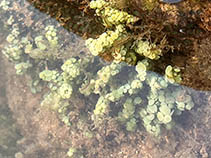Caulerpa racemosa (Forsskål) Agardh, 1873
Coarse seagrape| Native range | All suitable habitat | Point map | Year 2050 |

|
| This map was computer-generated and has not yet been reviewed. |
| Caulerpa racemosa AquaMaps Data sources: GBIF OBIS |
Classification / Names Common names | Synonyms | CoL | ITIS | WoRMS
Bryopsidophyceae | Bryopsidales | Caulerpaceae
Environment: milieu / climate zone / depth range / distribution range Ecology
Sessile; brackish; depth range 0 - 50 m (Ref. 83908). Tropical
Distribution Countries | FAO areas | Ecosystems | Occurrences | Introductions
Indo-Pacific, Atlantic Ocean and the Mediterranean.
Length at first maturity / Size / Weight / Age
Maturity: Lm ? range ? - ? cm
Short description Morphology
A highly variable species. The typical variety is characterized by short erect branches bearing crowded ramuli with short stalks and oval or spherical tips. The arrangement and shape of the ramuli differ among the numerous varieties.The ramuli can be sparse or dense, arranged radially, alternately, pinnately or irregular on the erect branch. The distal portion of the ramuli can be clavate, turbinate, globose truncate, or sometimes discoid. Plants growing on sandy substrate in calm, turbid water of the reef flat tend to have long erect branches densely covered with clavate or capitate ramuli while those growing on rocky-wave exposed portions of the reef possess strong short erect branches which bear crowded ramuli with spherical or globose tips. Erect branches up to 10 cm in height (Ref. 80758).
Used for human consumption and medicine: antifungal, lowers blood pressure; source of caulerpin, a substance with anaesthetic effect; also source of caulerpicin which has a toxic effect (Ref. 80758); with export potential from Fiji as fresh sea vegetable (Ref. 82232). Edible green seaweed (Ref. 82232).
Life cycle and mating behavior Maturity | Reproduction | Spawning | Eggs | Fecundity | Larvae
Main reference
References | Coordinator | Collaborators
Guiry, M.D. and G.M. Guiry. 2009. (Ref. 80701)
IUCN Red List Status (Ref. 130435: Version 2024-1)
CITES status (Ref. 108899)
Not Evaluated
CMS (Ref. 116361)
Not Evaluated
Threat to humans
Harmless (Ref. 80758)
Human uses
Fisheries: commercial
| FishSource |
Tools
More information
Trophic Ecology
Food items
Diet
Food consumption
Ration
Predators
Diet
Food consumption
Ration
Predators
Ecology
Population dynamics
Life cycle
Reproduction
Maturity
Fecundity
Spawning
Eggs
Egg development
Larvae
Larval dynamics
Maturity
Fecundity
Spawning
Eggs
Egg development
Larvae
Larval dynamics
Human Related
Aquaculture profile
Stamps, Coins Misc.
Stamps, Coins Misc.
Outreach
References
Internet sources
BHL | BOLD Systems | CISTI | DiscoverLife | FAO(Publication : search) | Fishipedia | GenBank (genome, nucleotide) | GloBI | Gomexsi | Google Books | Google Scholar | Google | PubMed | AlgaeBase | Tree of Life | Wikipedia (Go, Search) | Zoological Record
Estimates based on models
Preferred temperature
(Ref. 115969): 20.8 - 29.2, mean 27.8 (based on 5360 cells).



